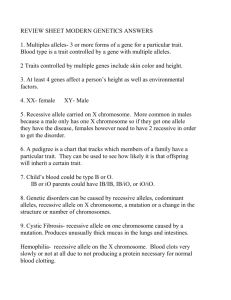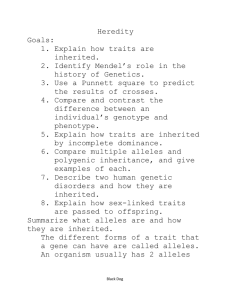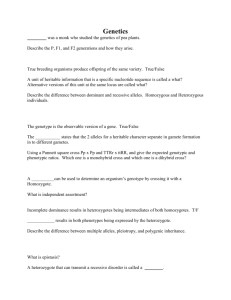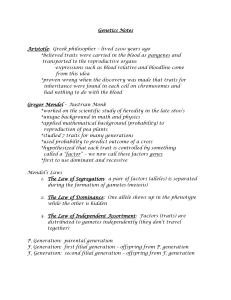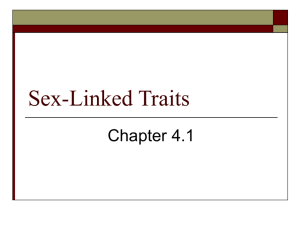Meiosis and Mendel*s Laws of Segregation and Independent
advertisement
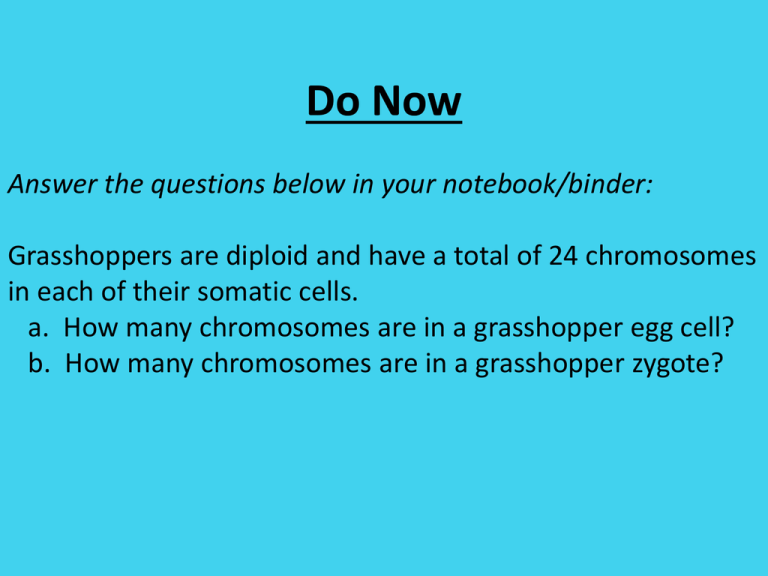
Do Now Answer the questions below in your notebook/binder: Grasshoppers are diploid and have a total of 24 chromosomes in each of their somatic cells. a. How many chromosomes are in a grasshopper egg cell? b. How many chromosomes are in a grasshopper zygote? Meiosis and Mendelian Genetics Vocabulary Heredity: the passing on of traits genetically from one generation to another. Genetics: the scientific study of heredity Trait: a specific characteristic that varies from one individual to another Probability: the chance that a particular event will happen Vocabulary Punnett square: a diagram that shows the gene combinations that might occur when two parents make offspring Homozygous: having two identical alleles for a particular trait (aa or AA) Heterozygous: having two different alleles for a particular trait (Aa) Vocabulary Phenotype: the physical characteristics of an organism (such as brown hair, freckles, a big nose) Genotype: the genetic make-up of an organism (AA, Aa, or aa) Dominant: a gene that can cover up the phenotype of a recessive allele Recessive: a gene whose trait can only be seen if there are no dominant alleles present Meiosis Review: Recall that during meiosis, homologous chromosomes pair up in the middle of the cell to form tetrads and cross over, leading to new combinations of genes on each chromatid. Meiosis Review: The four chromatids from the tetrad each end up in a different gamete Check for Understanding This diagram shows how chromosomes separate during meiosis. Did these chromosomes cross over? How can you tell? Gregor Mendel Gregor Mendel was an Austrian monk who studied the traits of the pea plants in his garden. He is often considered “The Father of Genetics.” His work was very important to the understanding of genetics. Mendelian Genetics Mendelian genetics only works with traits that are controlled by one gene. The presence of different alleles of that gene determines the Suppose this gene is the gene for a dimpled trait. chin. A dimpled chin is a trait that is only controlled by one gene, meaning that there is one location (loci) on this homologous pair of chromosomes that is for the dimpled chin gene. There are no other genes anywhere, on any chromosome, that control the dimpled chin trait. Some traits, like height and skin color, are controlled by many genes. For these traits, There are several genes with different loci. The genes may even be on different chromosomes Homozygous and heterozygous describe the genotype of an organism An organism that is homozygous for a trait has two copies of the same allele. If two dominant alleles are present, the organism is homozygous dominant for that trait. If two recessive alleles are present, the organism is homozygous recessive (PP or aa ) An organism that is heterozygous for a trait has two different alleles, and only the dominant allele is expressed in the phenotype. (Bb) 11 Examples Dracula has a widow’s peak, which is a dominant trait. We know Dracula must have at least one dominant allele for a widow’s peak (W). Dracula’s genotype could be homozygous dominant (WW) or heterozygous (Ww) If Dracula had no widow’s peak, he would be homozygous recessive (ww) 12 This is my friend Jace. Jace has naturally straight hair, which is a recessive trait. We know Jace’s genotype is homozygous recessive for straight hair (tt) A person with curly hair (the dominant trait) would have the genotype TT or Tt 13 Check for Understanding Having a dimple (or a cleft) in your chin is a dominant trait. The recessive trait is having a smooth or straight chin. What are the possible genotypes for Eminem’s chin? Use the letter D for the dominant allele and d for the recessive allele. Recall: Chromosomes Sex chromosomes are the X and Y chromosomes that determine an individual’s sex Autosomes are the rest of an individual’s chromosomes Humans have 23 pairs of chromosomes: One pair of sex chromosomes And 22 pairs of autosomes Human Chromosomes 15 Sex-Linked Traits Alleles for sex-linked traits can be located on either the X or Y chromosome. Most genes for sex-linked traits are located on the X chromosome (X-linked), simply because the X chromosome has many more genes than the Y chromosome 16 Remember when we watched Lorenzo’s Oil?!? Lorenzo Odone had a disease called ALD (adrenoleukodystrophy). This gene that causes this disease is on the X chromosome. Even though he got the gene from his mother, his mother did not have the disease because she has two X chromosomes, so her good gene on her other X chromosome was enough to keep her healthy. Because males have XY for their sex chromosomes, they will be affected by genes on the X chromosome. Example: Colorblindness Example: colorblindness is an X-linked, recessive trait. Since females have two X chromosomes, a female must have two alleles for colorblindness to be colorblind (one on each X chromosome). A female with only one allele for colorblindness is called a carrier, because she will not express the colorblind phenotype, but she may pass the colorblind allele to her offspring. Since males only have one X chromosome, they will be colorblind if they have the allele for colorblindness -The genotype of a male affected with colorblindness would be XCY -The genotype of a carrier female would be XCX -The genotype of female affected With colorblindness would be XCXC 18 X-Linked Traits X-linked recessive traits are called recessive because the other, normal allele on the second X chromosome in females can mask the trait. So a female with two X chromosomes must have two copies of the allele to express the X-linked recessive phenotype The Y chromosome has different genes than the X chromosome, so it cannot mask the allele on the X chromosome The X and Y chromosomes are not homologous 19 Check for Understanding If a woman who is colorblind has a son with a man who is not colorblind, what is the probability that the son will be colorblind? If a colorblind woman has a daughter with a colorblind man, what is the probability that the daughter will be colorblind? Punnett Squares A Punnett square is a diagram that shows the gene combinations that might occur when two parents make offspring The genotype of one parent is listed across the top, and the genotype of the other parent is listed down the left side. The four boxes inside represent the possible genotypes of the offspring Let’s fill in this Punnett Square together Let’s say the trait we are looking at is for height in pea plants. T represents the dominant tall allele, and t represents the recessive short allele. What are the genotypes of the parents in this Punnett square? What is the probability of having tall offspring? What is the probability of having short offspring? X-Linked Punnett Square Hemophilia is an Xlinked genetic disease. It causes blood to clot improperly, so people with the disease bleed longer than people without the disease. In this Punnett square, we are crossing a carrier female with a male who has hemophilia. Let’s do the first Punnett Square on your Punnett Square Worksheet together Note that eye color is really more complicated than this. This is a simplified example. 1. B= Brown eyes b= blue eyes Mom= Bb Dad= BB What are the eye color possibilities if they chose to have children? Be sure that you include the ratios of the genotypes (and the words used to describe those alleles) and phenotypes of the characteristics. True-breeding: a plant that always produces offspring with identical traits when it self-pollinates Hybrid: the offspring of plant parents with different traits Segregation: separation Independent assortment: the fact that genes for different traits end up in gametes independently of other traits. For example, your genes for hair color do not influence what genes you will get for your eye color. Mendelian Genetics Continued: The Laws of Segregation and Independent assortment Mendel’s Law of Segregation Check for Understanding Mendel’s Law of Independent Assortment Mendel’s Law of Independent Assortment okay Check for Understanding

